A couple of blocks away from the Mario Testino Museum which we visited first was the Museo Pedro de Osma housed in a stunning century-old
mansion that had belonged to Osma, a wealthy collector of religious art.
Here are the pieces I especially liked in the home's Silver Gallery that we visited initially. Mining was a significant asset in Peru, not only as a resource for its national coffers, but also for the creation of religious artifacts. Such pieces were used in liturgical ceremonies, religious processions, worship and altar ornaments and also in household objects.
What an exquisite 17th century cross:
An Eucharistic pelican from the 18th century from
Cusco in Peru's Sacred Valley:
A Tabernacle door also from Cusco from 1749:
A silver fish created in the 19th century in
Lima:
The sign said it was Conjunto of Zahumadores which meant it was from the Andean zone.
Rudolf without his red nose!
Ancient Inka gold coins:
Another hall of the museum featured Southern Andean Art from ancient Peru.
The museum had a superb collection of keros, ancient Inca drinking vessels used to drink liquids like alcohol, or more specifically, chicha. They were made from wood, ceramics, silver or gold and traditionally used in Andean feasts.
It was unusual to us seeing the Jug with Lateral Handle with a face in relief on the neck.Conopa were stone or wooden sculptures that were part of fertility and abundance ceremonies. Made in the shape of Andean camelids (alpacas, vicunas, llamas or guanacos - all animals you'll see in future posts), they had a cavity in the back where tallow was placed during ritual offerings.
The museum's manicured grounds were immaculate.
The Portrait Hall included many paintings from a time in Peru's history known as the vice-regal period where most artists painted a religious motif but some artists painted 'profane' themes. The most fashionable was the portrait which were very popular in the cities, especially Cusco and Lima.
The museum also gathered outstanding examples of oriental style furniture from the 17th and 18th centuries.
An 18th century wood table inlaid with mother-of-pearl and tortoise shell:Titled The Calvary and created in the 19th century:
I have no idea what Osma originally used this lovely room for but the sculptures currently in it were a joy to see. Sculpture was one of greatest art disciplines during the Peruvian Vice-Regal period. Carving and gilded wood remained constant throughout the era.
A 17th century sculpture of St. John the Evangelist, carved in wood:
Adam and Eve and Anthropomorphic Snake from the 18th century:
An anonymous artist carved The Immaculate Conception during the 18th century.
Breathtaking stained-glass windows were the centerpiece of
most rooms in the mansion.
In this painting in the Allegory Hall, the Church was depicted as a ship whose mast was formed with the figure of Christ on the cross. The ship is being attacked by the 'infidels' and defended by saints and pious men. Similarly, the Eucharistic allusions were represented by the figure of the Monstrance, a receptacle holding the consecrated Host, stored inside the sun formed by rays that symbolized the Holy Father and his light shining on the universe.The complex religious thinking that arrived form Europe was illustrated in signs and symbols which allowed the local population to easily interpret their meaning.
Just one of the elaborately-decorated ceilings that adorned the museum.
The elements that define the Cusco style were the use of European engraved plates, changes in techniques for making paint and mannerism replaced by the Baroque movement which brought big compositions full of movement and color.
The presence of gold on the religious canvases symbolized the importance of the metal in the Andean region since pre-Hispanic times. The development of these religious paintings had its influence in the signs and geometrical shapes that came from the ancient Inca empire. This new aesthetic was generalized toward 1750 in paintings, textiles, craftsmanship, etc. For the indigenous people to see the symbols of their religious past caused many rebellions.
One of the most important paintings was an engraving that showed the portraits of the Incas as it showed a break from the Spanish power. The Genealogy of the Incas was created in the 18th century.The Lord of the Tremors was an example of the 18th century Cusco School where the growing taste for gold in art was evident in most of the works. Gold played a role in religious paintings as a nod to the preferences of the colonial market but also referenced its symbolic value in ancient Peru.
From the Catholic countries of Europe, a group of Marian paintings, i.e. of the Virgin Mary, arrived in the continent. They were either images designated for the altars or art works sponsored by religious orders to be used in the evangelization. Interpretation of the sacred stories by the local population combined with miracles and apparitions of local legends gave birth to a series of Peruvian Marian Titles.
Most of the Marian Titles took the name of their place of worship. The finest of the paintings was the 18th century Virgen de Pomato in the center below. It represented the
Earth with her mountain-shaped cloak covered with garlands of corn.
Another hall was devoted to paintings of Angels and Archangels, European art forms assimilated by sectors of the population as objects of worship after associating them with pre-Hispanic winged images or warrior birds.
The 18th century oil painting Archangel Ariel was representative of the harquebusier archangel based on the most common form of cavalry found throughout Western Europe during the early and mid-17th century. Colonial painters imagined this type of archangel as eternally young, asexual and dressed in long robes or in military uniform.
One room was dominated by a gilded altar.
Huamanga stone carvings often featured a profusion of religious topics but well into the 19th century they gave way to secular themes portraying gallant figures and women wearing the current fashions.Our visit to the Museo Pedro de Osma had been a wonderful introduction to the world of art in colonial Peru. How fortunate that we just happened to stop by because of its proximity to our guesthouse in the Barranco neighborhood of Lima.
We then strolled a few blocks to the Barranco Municipal Park.
Elegant royal palms, swirls of bougainvillea and the surrounding colonial
architecture made this park stand out from others in Lima.
The neighborhood library with its distinctive clock tower was located in the park.
In the north end of the park was Barranco’s Iglesia de la Santisima Cruz or Church
of the Holy Cross. The church was only open for Mass every evening and Sunday
mornings.
Steven joked we could come back to Lima in January to see
the pope on his 70th birthday!
Historical signs talked of the district's 'enchanted tourist attractions, the streets that tell great stories' and that 'there was no place in Barranco without magic!' We were curious to see more!
A staircase led down to the Puente de los Supiros with the La
Ermita, a little yellow chapel dating from 1882, in the background.
The romantically named Bridge
of Sighs was a wooden walkway over a promenade the local fishermen used in
the past to reach their boats. But to name it after the legendary Venetian
landmark was more than a stretch!
The town’s marketers had certainly done a great job hyping
what was really pretty ugly and tacky!
You can tell that Steven wasn't too impressed by the lookout, either, much preferring to take advantage of the nearby place to sit down!
We took the bus next to the Miraflores
section of Lima as there were more churches, parks and sights to see.
The area is known for its Parque Kennedy that we wanted to explore.
It was interesting to read that a group of Miraflores residents known as the Feline Defense Volunteer Group have spent more than 20 years protecting the 'Kennedy Park Kittens' without any assistance from the government or private institutions. They make sure the cats are vaccinated, treated for parasites and, where possible, given up for adoption to caring and loving homes. The group has organized adoption campaigns every weekend for more than ten years!
Cats have lived in Parque Kennedy for 25 years and there are two communities of feral cats that have been born in the park. In addition, domestic cats are abandoned there on a daily basis and they are the focus of the group's adoption campaign. Neither Steven or I are cat lovers but I applauded the group's dedication and zeal to a cause they must feel very strongly about.
I was interested in looking at souvenirs as you might have
guessed, Darlene, so we headed over to the Indian
Market.
We saw bags and bags of finger puppets in so many different
animal shapes.
This was certainly the place to shop for alpaca scarves if you were in the market for one as the selection was great. The prices - not so much!
I sure didn't have room in my bag for any of the yarn although my fingers itched to knit again!
We couldn’t figure what was up with all the pompom things
everywhere. They were pretty but …
We couldn't get away from the pompoms!
Too bad I didn't have a reason to buy a few of these adorable stuffed animals!
Next post: Pyramids, yup pyramids, in Lima later that afternoon!
Posted on December 10th, 2017, from Sao Paolo, Brazil.





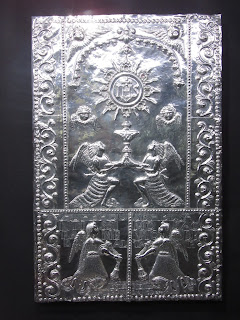







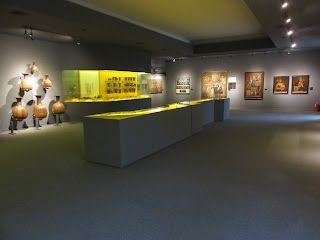

























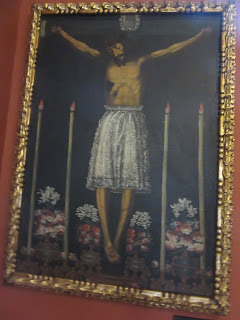










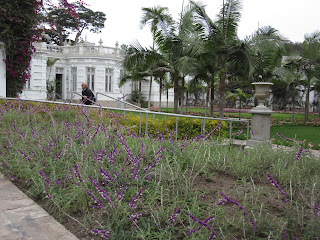




























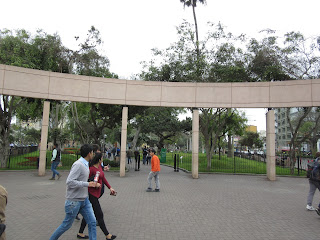

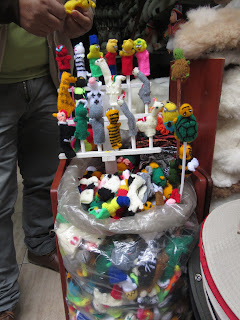











Yeah, lots of yarn from Peru!!!!! Lil Red
ReplyDeleteLil Red,
DeleteYarn was everywhere we looked but I had to restrain myself from buying any because of space concerns in our bags and already having a large enough stash of yarn at home. Am looking forward to delving into the stash and my collection of patterns to start knitting again.
Caroline brought me back an alpaca scarf from Peru -- brilliant red colour but it does "shed" a wee bit.
ReplyDeleteENJOY the vibrant colours and culture of Peru! xo Lina
Lina,
ReplyDeleteIt was impossible NOT to relish the vibrant colors and culture of Peru, a country we loved touring.